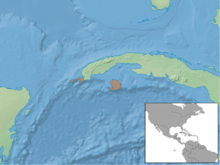Cuban greater funnel-eared bat
| Cuban greater funnel-eared bat | |
|---|---|
| Scientific classification | |
| Kingdom: | Animalia |
| Phylum: | Chordata |
| Class: | Mammalia |
| Order: | Chiroptera |
| Family: | Natalidae |
| Genus: | Natalus |
| Species: | N. primus |
| Binomial name | |
| Natalus primus (Anthony, 1919) | |
 | |
The Cuban greater funnel-eared bat (Natalus primus) is a species of funnel-eared bat. It is endemic to a cave on Isla de la Juventud (Isle of Pines) in Cuba.[2] Natalus primus is a member of the order Chiroptera and the family Natalidae.[3]
Taxonomy
The bats within the genus Natalus have had a complex taxonomic history due to its morphological conservatism.[4] The taxonomy of Natalidae has been recently updated by the discovery and rediscovery of live species and fossils, and on the basis of new morphological and molecular evidence.[5]
Description
The Cuban greater funnel-eared bat has funnel-like ears and a tail as long as the head and body combined.[6] They have black, stiff hairs above the upper lip, much like a moustache, and white hairs below the lower lip. They have tan and reddish-brown fur with a paler belly.[7]
These bats have a diet consisting largely of moths, crickets, and beetles.[8] In 1992, the first living population was discovered in a cave in Cueva La Barca.[6] Caribbean hurricanes early in the evolutionary history of Natalids may account for specialized cave roosting.[9]
Conservation
Natalus primus is considered vulnerable and only inhabits one cave in Cueva La Barca on Isla de la Juventud island and province.[10] The population is abundant in that single cave, but this species is likely to go extinct due to its limited dispersal range,[6] human disturbance and loss of habitat.[11] It is estimated that there are only 100 mature individuals.[8]
This species is known to have become extirpated throughout most of Cuba suggesting a population decline that may have continued until the present.[12] The survival of Cuban bats is threatened by forest destruction and cave modification.[13]
Habitat loss through erosion is a major concern. The ongoing collapse of the cave roof is likely to upset the thermal balance in this hot cave and result in Natalus primus extinction.[6] Cave-dwelling Cuban bat species conservation should be a cooperative effort promoting research and habitat management.[13]
References
- ↑ Mancina, C. (2016). "Natalus primus". The IUCN Red List of Threatened Species. IUCN. 2016: e.T136777A22032828. doi:10.2305/IUCN.UK.2016-1.RLTS.T136777A22032828.en. Retrieved 15 December 2017.
- ↑ Dávalos, L. & Mancina, C. (2008). "Natalus primus". IUCN Red List of Threatened Species. Version 2012.2. International Union for Conservation of Nature. Retrieved 31 August 2013.
- ↑ "Mammal's Planet - Species Sheet - Cuban Greater Funnel-eared Bat, Cuban Yellow Bat". Ch Boudet. Retrieved 2014-02-23.
- ↑ López-Wilchis, Ricardo; Luis M. Guevara-Chumacero; Neófito ángeles Pérez; Javier Juste; Carlos IbáñEz; Irene D. L. A. Barriga-Sosa (December 2012). "Taxonomic Status Assessment of the Mexican Populations of Funnel-Eared Bats, Genus Natalus (Chiroptera: Natalidae)". Acta Chiropterologica. 2. 14: 305–316. doi:10.3161/150811012x661639. Retrieved 2014-02-23.
- ↑ Tejedor, Adrian (2011). "Systematics of Funnel-Eared Bats (Chiroptera: Natalidae)". Bulletin of the American Museum of Natural History. 353: 1–140. doi:10.1206/636.1. Retrieved 2014-02-23.
- 1 2 3 4 "Edge - Cuban Greater Funnel-Eared Bat (Natalus primus)". The Zoological Society of London. Retrieved 2014-02-23.
- ↑ "Funnel-Eared Bats: Natalidae - Funnel-eared Bat (natalus Stramineus): Species Account". Net Industries. Retrieved 2014-02-24.
- 1 2 "The IUCN Red List of Threatened Species - Natalus primus". International Union for Conservation of Nature and Natural Resources. Retrieved 2014-02-23.
- ↑ Dávalos, LM (October 2005). "Molecular phylogeny of funnel-eared bats (Chiroptera: Natalidae), with notes on biogeography and conservation". Molecular Phylogenetics and Evolution. 37 (1): 91–103. doi:10.1016/j.ympev.2005.04.024. PMID 15967682. Retrieved 2014-02-23.
- ↑ "Critical Ecosystem Partnership Fund - Conservation Outcomes - Caribbean Islands". Conservation International. Retrieved 2014-02-23.
- ↑ "The world's 100 most threatened species - Are they priceless or worthless?". Wildlife Extra. Retrieved 2014-02-23.
- ↑ Tejedor, Ardian; Valeria DA C. Tavares; Gilberto Silva-Taboada (2005-10-27). "A Revision of Extant Greater Antillean Bats of the Genus Natalus". American Museum Novitates. 3493. Retrieved 2014-02-23.
- 1 2 Mancina, Carlos; Làzrao Echenique-Diaz; Adrian Tejedor; Lainet Garcìa; Angel Daniel-Alvarez; Miguel Ortega-Huerta (2007). "Endemics under threat: an assessment of the conservation status of Cuban bats". Hystrix - The Italian Journal of Mammalogy. 18 (1). Retrieved 2014-02-23.
